Improve Temporal Fourier Transform Profilometry for Complex Dynamic Three-Dimensional Shape Measurement
Abstract
:1. Introduction
2. Principle and Equipment
2.1. Temporal Fourier Transform Profilometry Method
2.2. Three-Dimensional Phase Unwrapping Based on Reference Plane
- (1)
- For the deformed fringe pattern captured by camera, 1-D Fourier transform, spectrum filtering and inverse Fourier transform are performed along the time axis on each pixel, getting the 3-D wrapped phase distribution data of a measured dynamic object.
- (2)
- Calculating the unwrapped phase of the reference plane measured on the same system.
- (3)
- Choosing one wrapped phase of the tested object at sampling time t1, in which, the object’s corresponding height changes within a suitable range. And comparing 2π with the phase difference between and to get the multiple integer K for each pixel, which must satisfy the following conditionIn other words, K can be determined aswhere, ceil [*] is the ceiling operator that gives the nearest upper integer number.
- (4)
- Adding 2Kπ to to get its unwrapped phase
- (5)
- Taking as the benchmark of the 3-D phase unwrapping and performing the 1-D phase unwrapping along the temporal axis, then finally obtaining the 3-D unwrapped phase distribution.
2.3. High-speed Measurement System and Framework of the Proposed Method
2.4. System Calibration
3. Experiments and Results
3.1. Accuracy Analysis
3.2. Comparative Experiments on Isolated Objects
3.3. Measurement of an Impact Process
4. Discussion
- A new absolute phase of an isolated, steep object can be recovered from a new distorted sinusoidal fringe pattern. For a dynamic measured scene, compared with FTP, TFTP can also get new height information from each new distorted fringe pattern, and the motion error is avoided. Moreover, TFTP does not filter in the spatial domain but in the temporal domain, avoiding the spectral overlapping caused by the information loss of some pixels in the spatial domain and the smoothing effect of spatial Fourier regarding steep objects. The absolute phase recovery, pixel-by-pixel, is realized by introducing the unwrapping phase of the reference plane and unwrapping the 3-D wrapped phase distribution along the temporal axis. The difference is, for the TFTP method, data processing operations should be carried out after all the deformed fringe patterns are acquired.
- TFTP have a better performance in the dynamic measured scene. In the improved TFTP method, a new 3-D reconstruction result can be obtained from each new deformed fringe pattern. Compared with the PMP method and temporal phase unwrapping method, the improved TFTP will not cause a motion error in high-speed measurement. Nevertheless, in the TFTP method it is expected that the sampling theorem must be satisfied in the temporal domain because of the use of Fourier fringe analysis along the temporal axis (at least four sampling points per period to avoid spectrum overlapping). In other words, although the measured scene is isolated in the spatial domain, it is still continuous on each pixel along the temporal axis under a high-speed recording. When projecting N-step phase-shifting fringe patterns, it is required that N must be more than or equal to 4 to ensure that each period has four sampling points (In this paper, we adopt the nine-step phase-shifting). Once the sampling theorem in the temporal domain is not satisfied, the accuracy of the TFTP method will be affected. Therefore, for objects with complex dynamic distributions, the reconstruction accuracy of the TFTP method is between those of the FTP method and PMP method. In short, TFTP has a better performance on the dynamic measured scene and high-speed device can offer a better guarantee of the continuity in temporal domain.
- A fast, low-cost and flexible structured light pattern sequence projector is presented. In this paper, we presented a self-made mechanical projector to offer a better guarantee of the sampling theorem for the TFTP method. Our self-made projector generates sinusoidal fringe by the defocusing method and can reach the projection speed of thousands of frames per second. The signal part on the dics can accurately feedback the phase-shifting information and control the camera to capture the corresponding deformed pattern simultaneously. In addition, the dics is easy to change according to different measurement scenarios. In the measurement process, the measuring speed of the device is only limited by the shooting speed of the high-speed camera. Moreover, it is worth reminding that the sinusoidal feature generated from the defocused binary pattern will be affected by the defocusing degree, which is a common limitation of the binary defocusing method. So, if the measured height’s change exceeds the measurable depth range of the current binary defocusing, this proposed method will produce reconstruction error or even lead to failure.
- The different spatial frequencies are adopted to match the measured process with different complexities. It is a simple and effective method by introducing the reference plane to assist the absolute phase recovery of the 3-D wrapped phase distribution. According to the nature of the principle, the height change of the measured object must have one moment within the phase change of 2π corresponding to the height change range during the measurement. However, it is worth mentioning that the period of the projected sinusoidal fringe in the spatial domain does not affect the accuracy of the TFTP method (even the single-period sinusoidal fringe can be used). We can choose different spatial frequencies according to different measurement scenarios. For a special measured scene, in which the depth change at each moment in the measurement process is large, we can adopt the large period fringe projection to guarantee feasibility of 3-D phase unwrapping based on the reference plane.
5. Conclusions
Supplementary Materials
Author Contributions
Funding
Conflicts of Interest
References
- Su, X.; Zhang, Q. Dynamic 3D Shape Measurement Method: A Review. Opt. Laser Eng. 2010, 48, 191–204. [Google Scholar] [CrossRef]
- Zhang, S. Recent Progresses on Real-time 3-D Shape Measurement Using Digital Fringe Projection Techniques. Opt. Laser Eng. 2010, 48, 149–158. [Google Scholar] [CrossRef]
- Srinivasan, V.; Liu, H.C.; Halioua, M. Automated Phase-measuring Profilometry of 3-D Diffuse Objects. Appl. Opt. 1984, 23, 3105–3108. [Google Scholar] [CrossRef]
- Su, X.Y.; Von, B.G.; Vukicevic, D. Phase-stepping Grating Profilometry: Utilization of Intensity Modulation Analysis in Complex Objects Evaluation. Opt. Commun. 1993, 98, 141–150. [Google Scholar] [CrossRef]
- Zhang, S.; Yau, S.T. High-resolution, Real-time 3-D Absolute Coordinate Measurement Based on a Phase-Shifting Method. Opt. Express 2006, 14, 2644–2649. [Google Scholar] [CrossRef]
- Huang, P.S.; Zhang, S. Fast Three-step Phase-shifting Algorithm. Appl. Opt. 2006, 45, 5086–5091. [Google Scholar] [CrossRef]
- Takeda, M.; Ina, H.; Kobayashi, S. Fourier-transform Method of Fringe-pattern Analysis for Computer-Based Topography and Interferometry. J. Opt. Soc. Am. A 1982, 72, 156–160. [Google Scholar] [CrossRef]
- Su, X.; Chen, W. Fourier Transform Profilometry: A Review. Opt. Laser Eng. 2001, 35, 263–284. [Google Scholar] [CrossRef]
- Zhang, Z.; Zhong, J. Applicability Analysis of Wavelet-transform Profilometry. Opt. Express 2013, 21, 18777–18796. [Google Scholar] [CrossRef]
- Zhong, J.; Weng, J. Phase Retrieval of Optical Fringe Patterns From the Ridge of a Wavelet Transform. Opt. Lett. 2005, 30, 2560–2562. [Google Scholar] [CrossRef]
- Kemao, Q. Windowed Fourier Transform for Fringe Pattern Analysis. Appl. Opt. 2004, 43, 2695–2702. [Google Scholar] [CrossRef]
- Goldstein, R.M.; Zebker, H.A.; Werner, C.L. Satellite Radar Interferometry: Two-dimensional Phase Unwrapping. Radio Sci. 1988, 23, 713–720. [Google Scholar] [CrossRef] [Green Version]
- Flynn, T.J. Two-dimensional Phase Unwrapping with Minimum Weighted Discontinuity. J. Opt. Soc. Am. A 1997, 14, 2692–2701. [Google Scholar] [CrossRef]
- Su, X.; Chen, W. Reliability-guided Phase Unwrapping Algorithm: A Review. Opt. Laser Eng. 2004, 42, 245–261. [Google Scholar] [CrossRef]
- Huntley, J.M.; Saldner, H. Temporal Phase-unwrapping Algorithm for Automated Interferogram Analysis. Appl. Opt. 1993, 32, 3047–3052. [Google Scholar] [CrossRef]
- Cheng, Y.Y.; Wyant, J.C. Two-wavelength Phase Shifting Interferometry. Appl. Opt. 1984, 23, 4539–4543. [Google Scholar] [CrossRef]
- Gushov, V.I.; Solodkin, Y.N. Automatic Processing of Fringe Patterns in Integer Interferometers. Opt. Laser Eng. 1991, 14, 311–324. [Google Scholar] [CrossRef]
- Zuo, C.; Huang, L.; Zhang, M. Temporal Phase Unwrapping Algorithms for Fringe Projection Profilometry: A Comparative Review. Opt. Laser Eng. 2016, 85, 84–103. [Google Scholar] [CrossRef]
- Zhang, S. High-speed 3-D Shape Measurement With Structured Light Methods: A Review. Opt. Laser Eng. 2018, 106, 119–131. [Google Scholar] [CrossRef]
- Wang, Y.; Liu, Z.; Jiang, C.; Zhang, S. Motion Induced Phase Error Reduction Using a Hilbert transform. Opt. Express 2018, 26, 34224–34235. [Google Scholar] [CrossRef]
- Liu, Z.; Zibley, P.C.; Zhang, S. Motion-induced Error Compensation for Phase Shifting Profilometry. Opt. Express 2018, 26, 12632–12637. [Google Scholar] [CrossRef] [PubMed]
- Zhang, H.; Zhang, Q.; Li, Y.; Liu, Y.L. High-speed 3-D Shape Measurement with Temporal Fourier Transform Profilometry. Appl. Sci. 2019, 9, 4123. [Google Scholar] [CrossRef] [Green Version]
- Wissmann, P.; Forster, F.; Schmitt, R. Fast and Low-cost Structured Light Pattern Sequence Projection. Opt. Express 2011, 19, 24657–24671. [Google Scholar] [CrossRef] [PubMed]
- Heist, S.; Lutzke, P.; Schmidt, I. High-speed three-dimensional shape measurement using GOBO projection. Opt. Laser Eng. 2016, 87, 90–96. [Google Scholar] [CrossRef]
- Heist, S.; Dietrich, P.; Landmann, M. GOBO Projection for 3-D Measurements at Highest Frame Rates: A Performance Analysis. Light-Sci. Appl. 2018, 7, 71. [Google Scholar] [CrossRef] [PubMed]
- Hyun, J.S.; Chiu, G.T.; Zhang, S. High-speed and High-accuracy 3-D Surface Measurement Using a Mechanical Projector. Opt. Express 2018, 26, 1474–1487. [Google Scholar] [CrossRef]
- Li, W.; Su, X.; Liu, Z. Large-scale Three-dimensional Object Measurement: A Practical Coordinate Mapping and Image Data-patching Method. Appl. Opt. 2001, 40, 3326–3333. [Google Scholar] [CrossRef]
- Lei, S.; Zhang, S. Flexible 3-D Shape Measurement Using Projector Defocusing. Opt. Lett. 2009, 34, 3080–3082. [Google Scholar] [CrossRef]
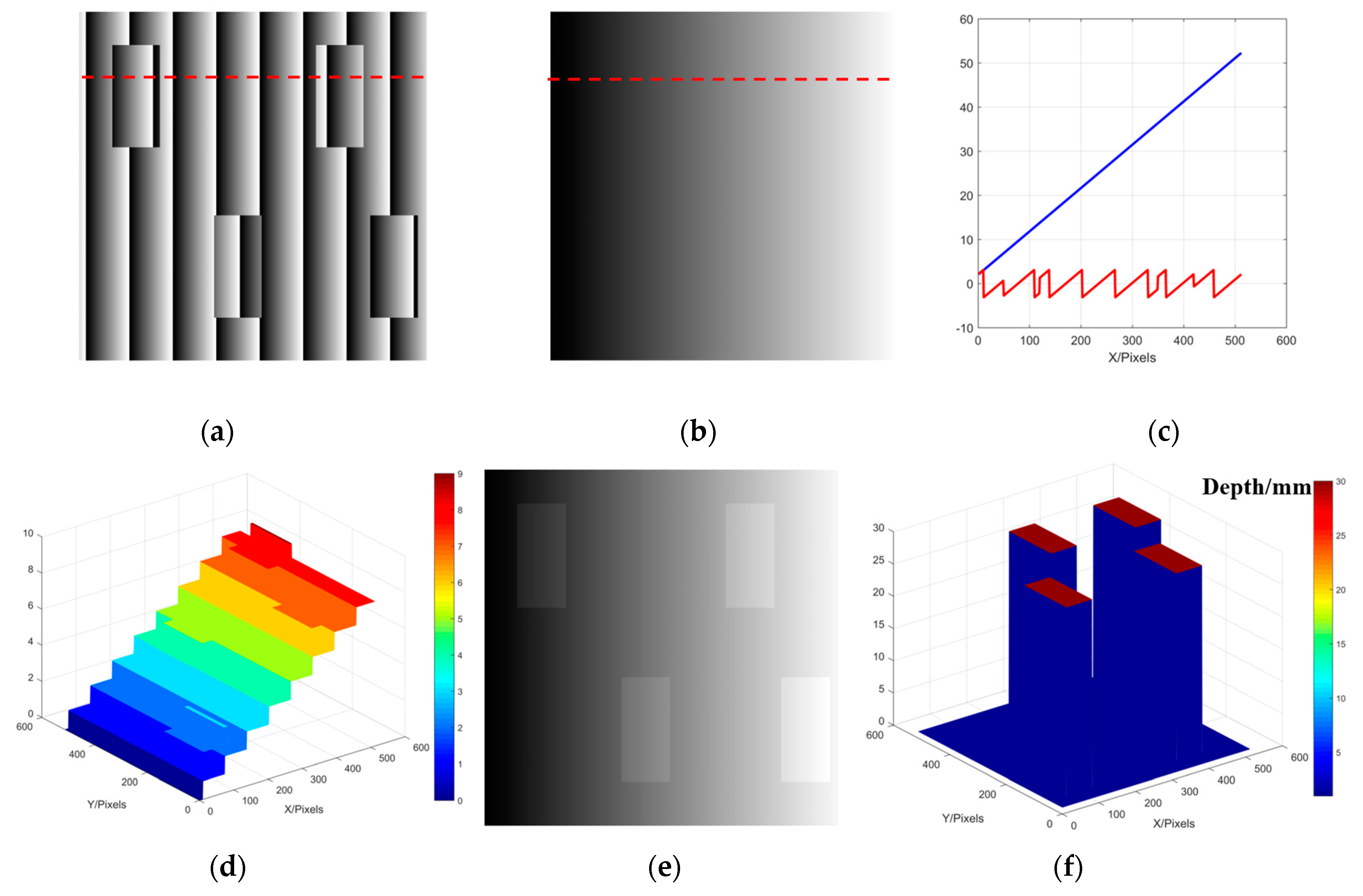
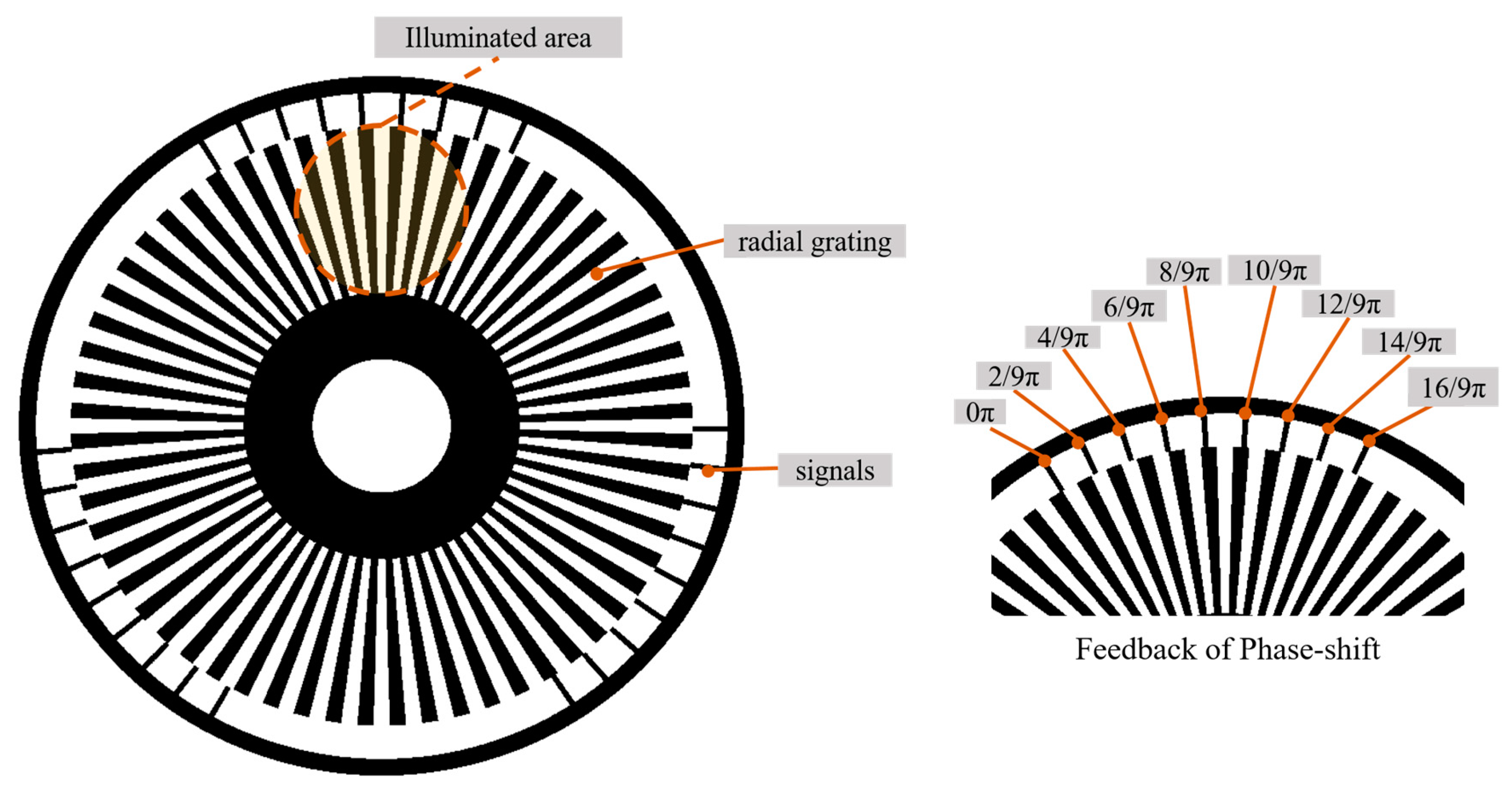
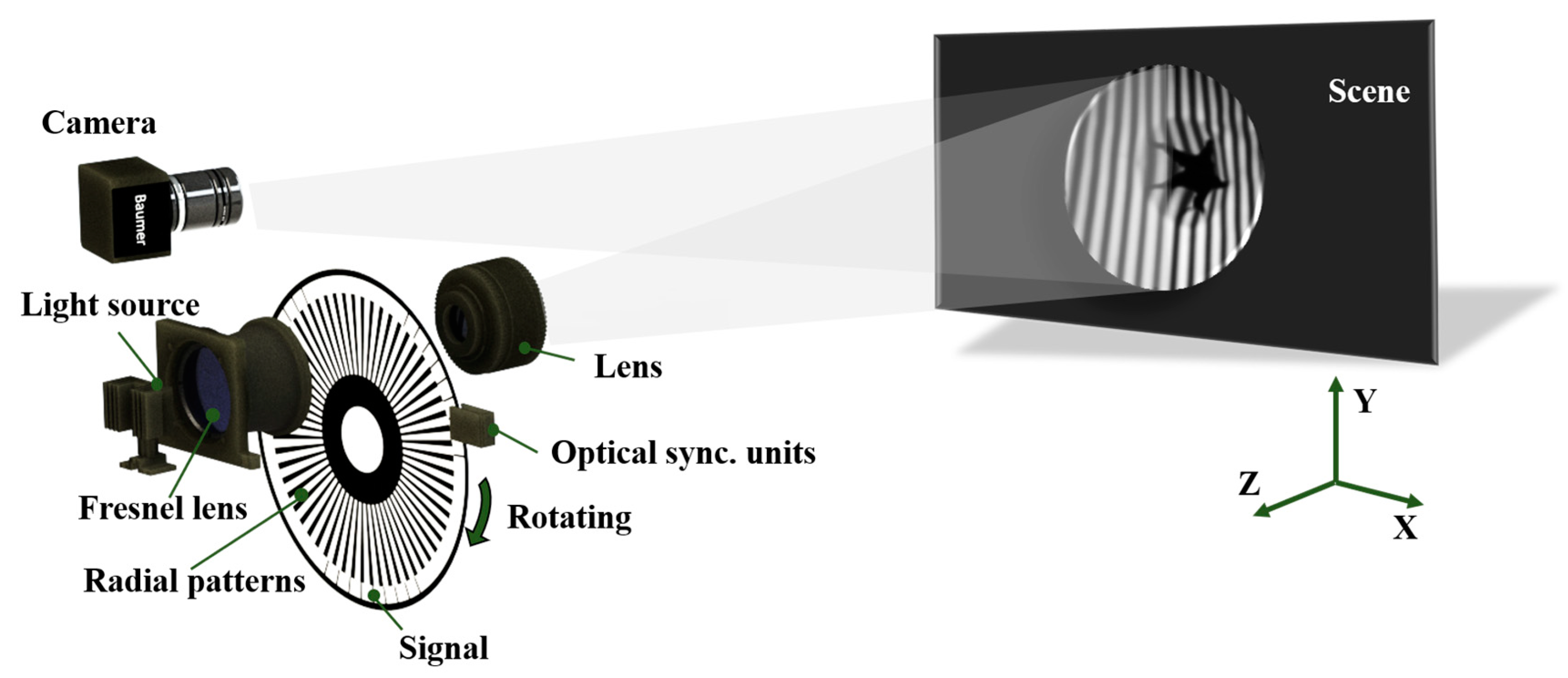
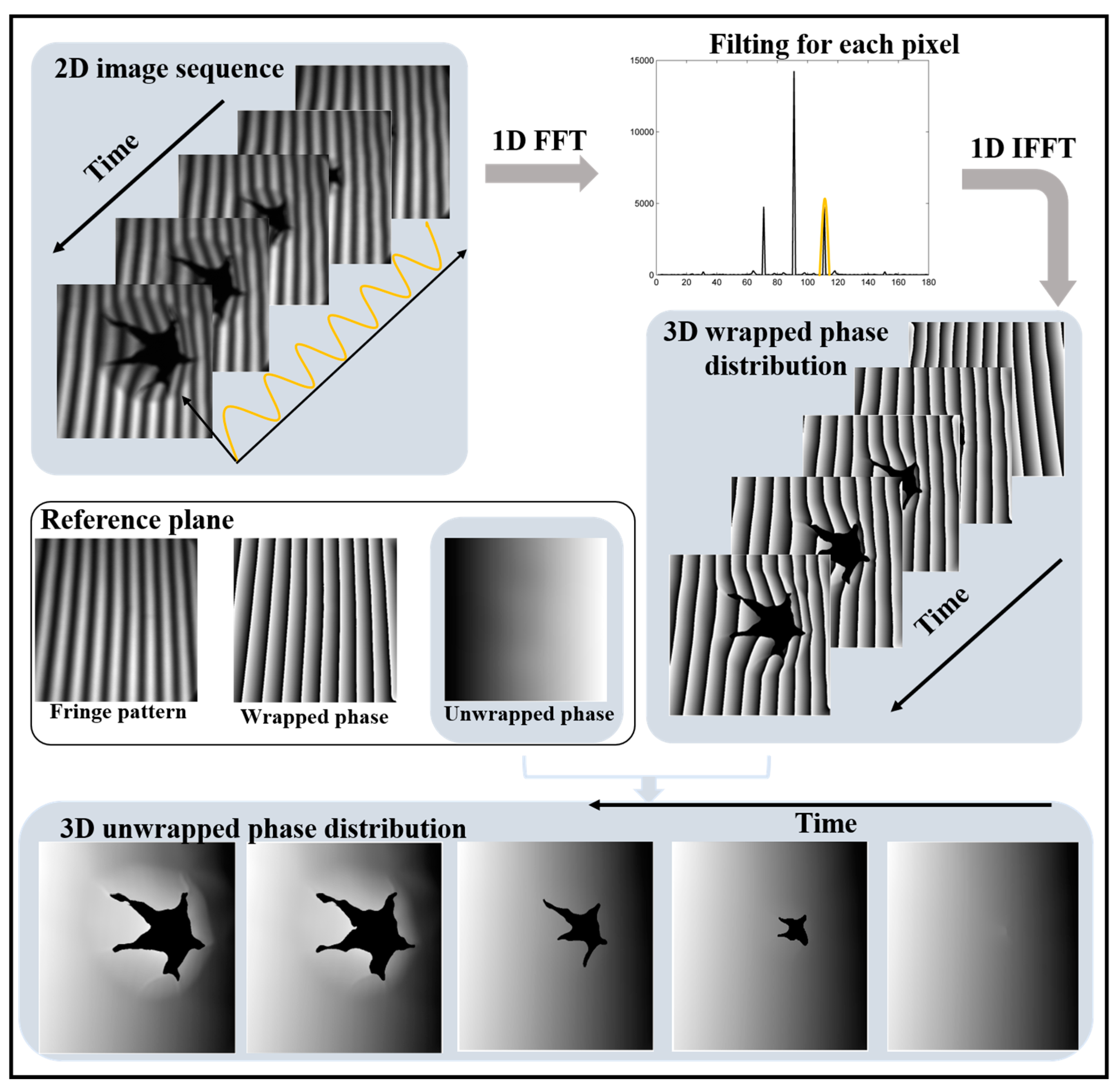
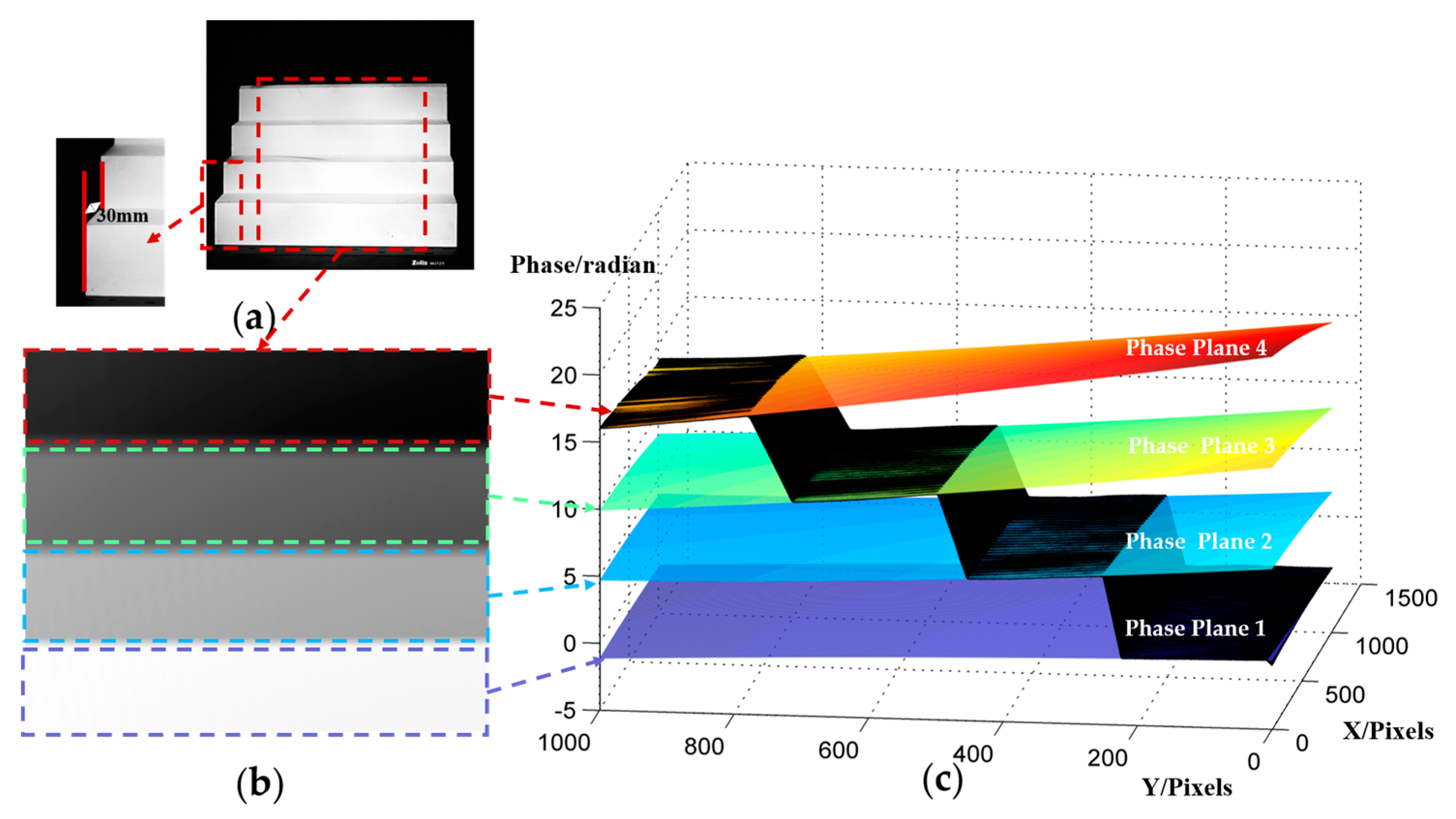
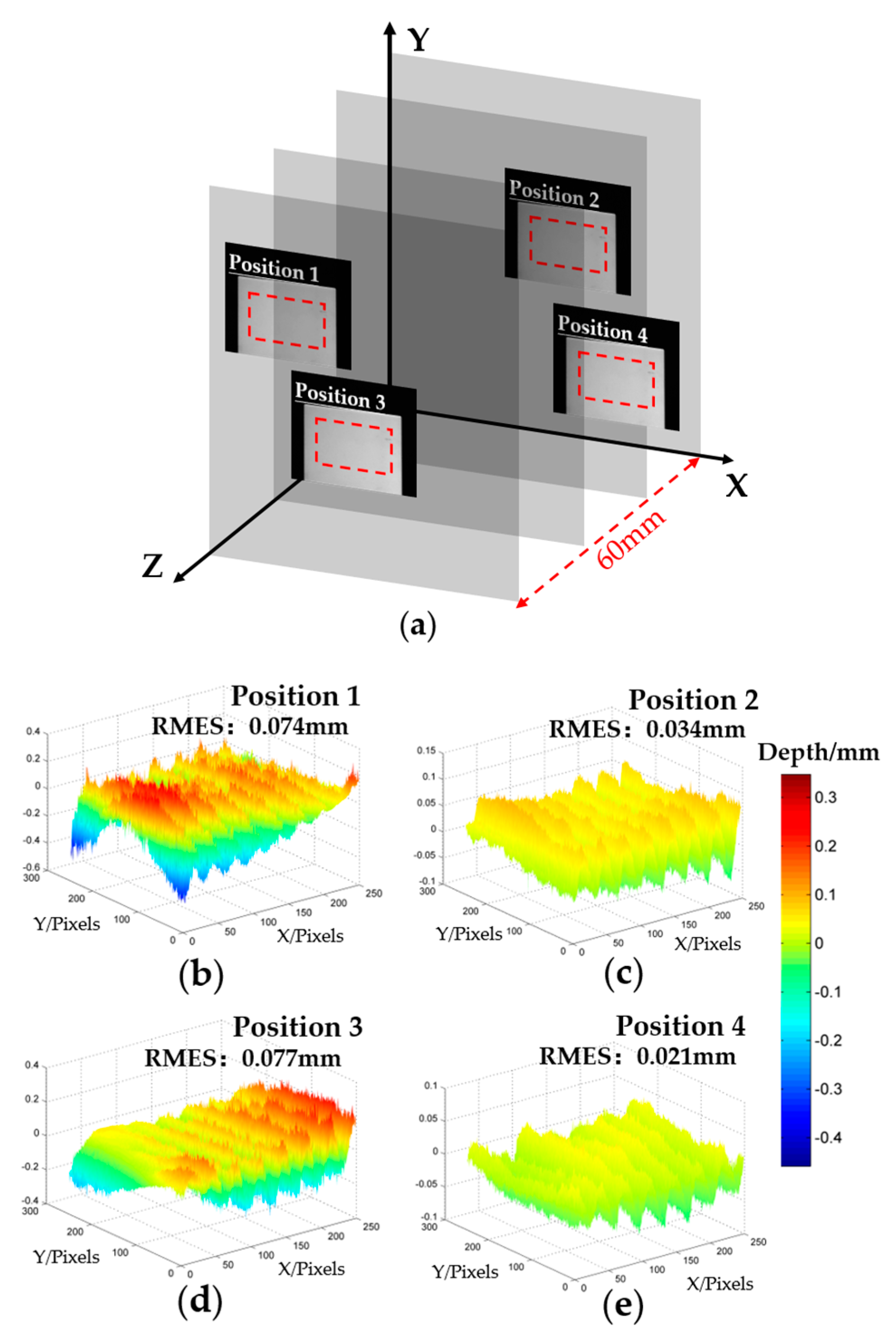
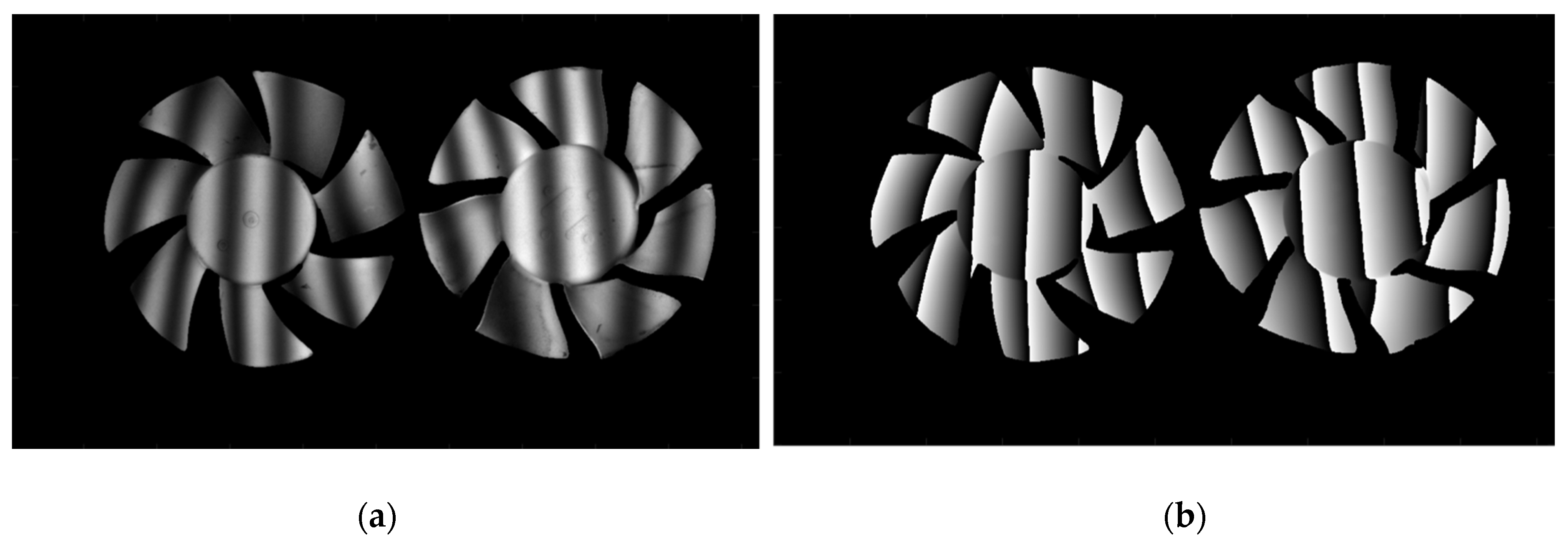
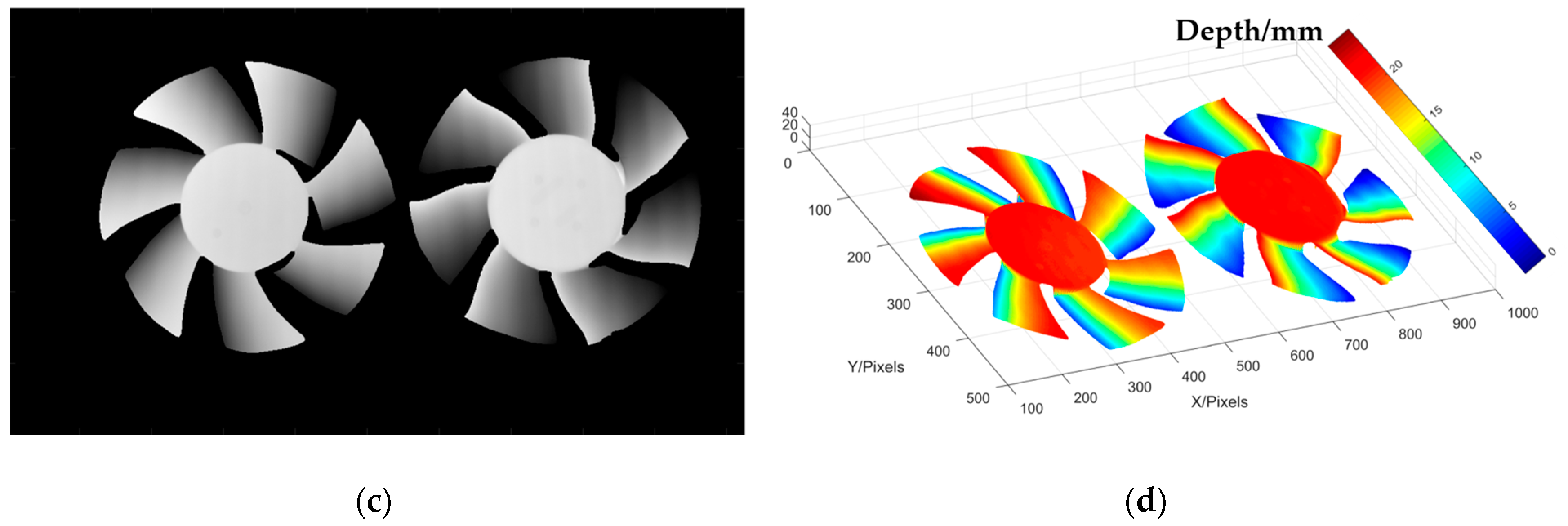
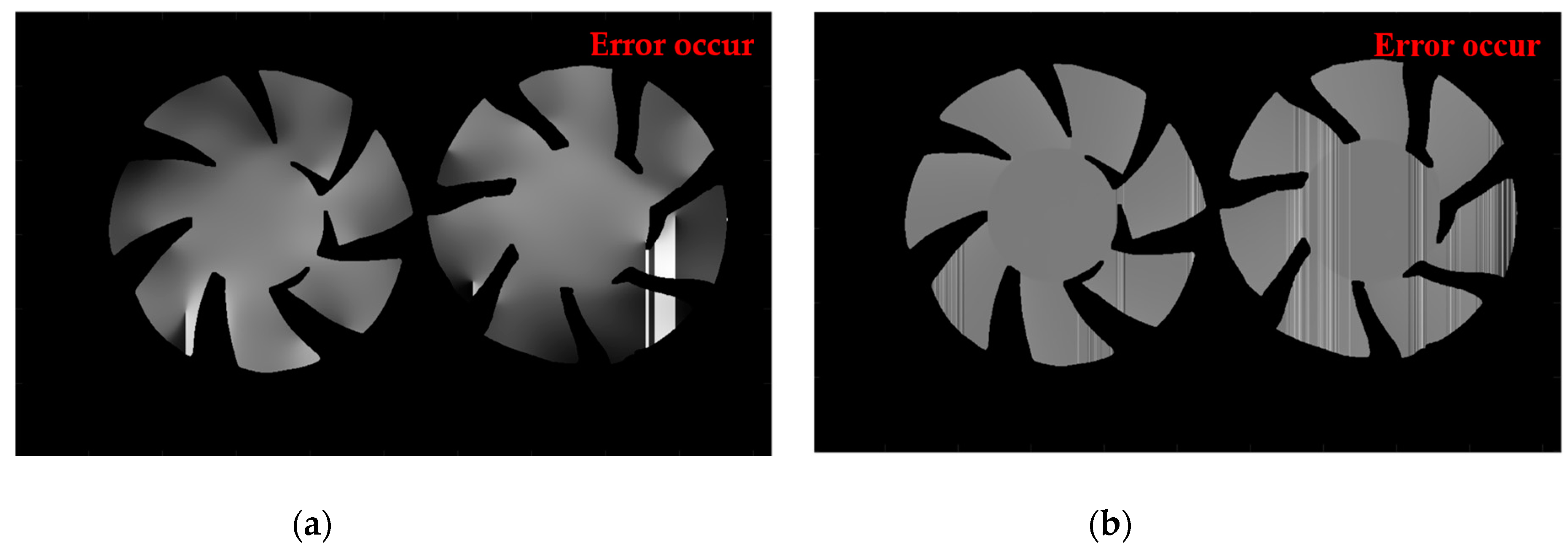
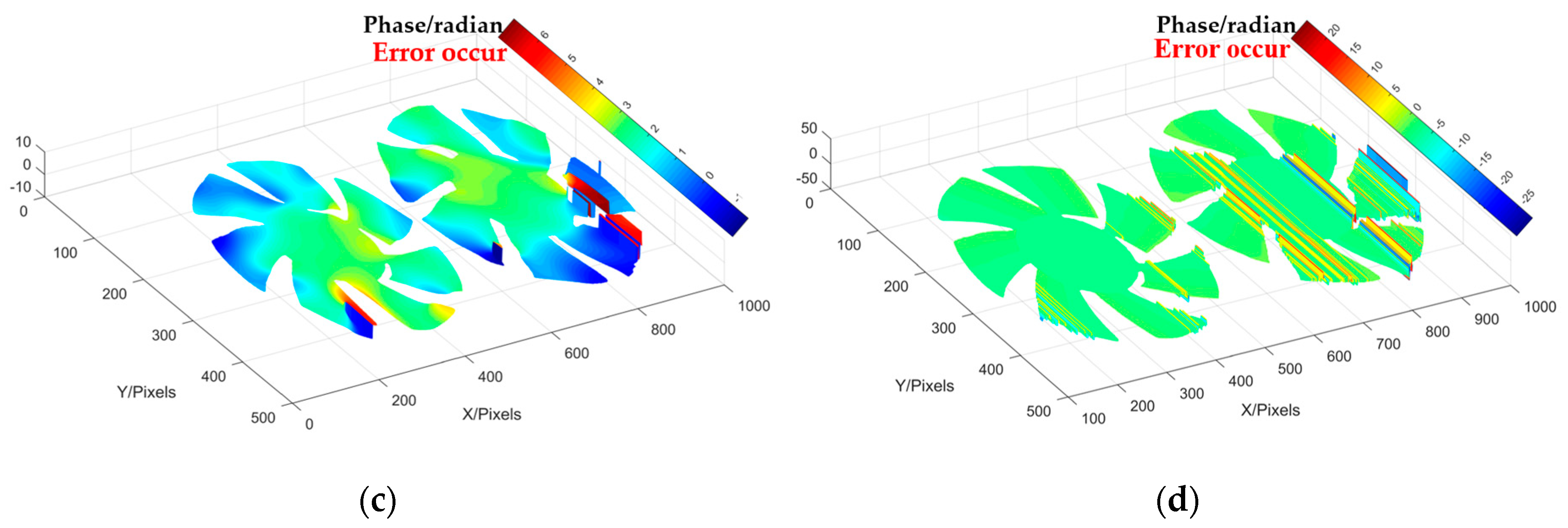

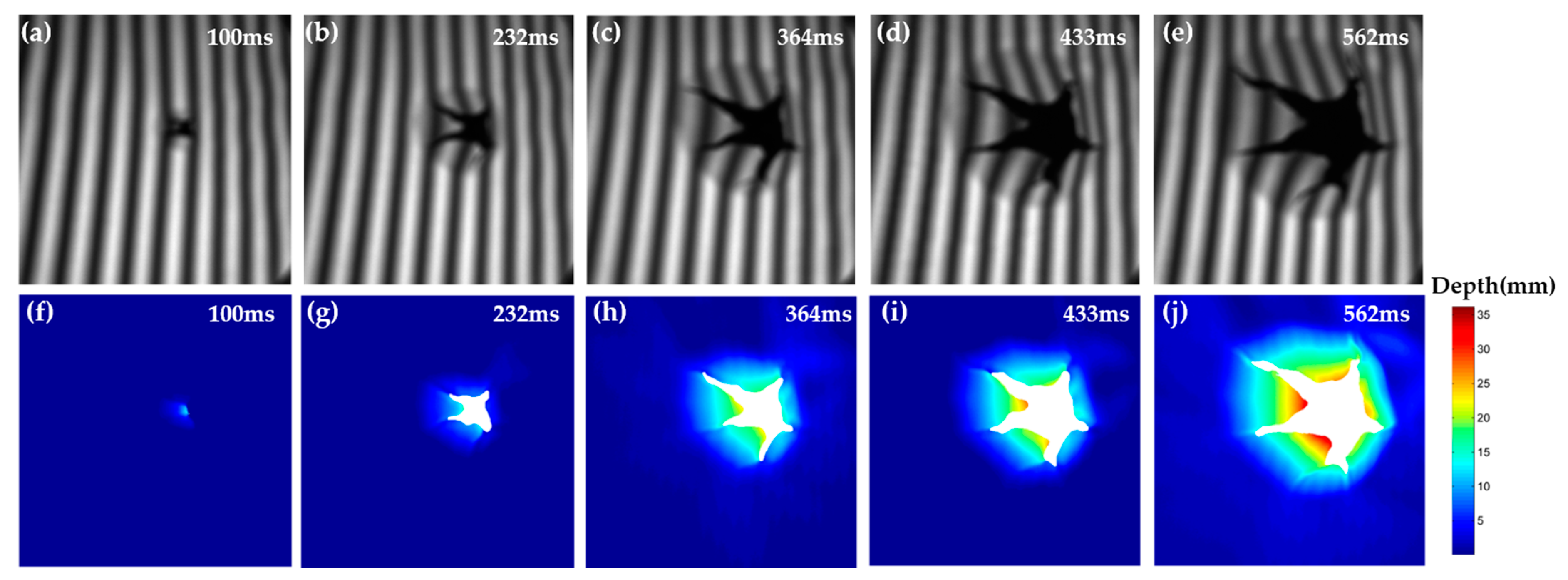
© 2020 by the authors. Licensee MDPI, Basel, Switzerland. This article is an open access article distributed under the terms and conditions of the Creative Commons Attribution (CC BY) license (http://creativecommons.org/licenses/by/4.0/).
Share and Cite
Liu, Y.; Zhang, Q.; Zhang, H.; Wu, Z.; Chen, W. Improve Temporal Fourier Transform Profilometry for Complex Dynamic Three-Dimensional Shape Measurement. Sensors 2020, 20, 1808. https://doi.org/10.3390/s20071808
Liu Y, Zhang Q, Zhang H, Wu Z, Chen W. Improve Temporal Fourier Transform Profilometry for Complex Dynamic Three-Dimensional Shape Measurement. Sensors. 2020; 20(7):1808. https://doi.org/10.3390/s20071808
Chicago/Turabian StyleLiu, Yihang, Qican Zhang, Haihua Zhang, Zhoujie Wu, and Wenjing Chen. 2020. "Improve Temporal Fourier Transform Profilometry for Complex Dynamic Three-Dimensional Shape Measurement" Sensors 20, no. 7: 1808. https://doi.org/10.3390/s20071808
APA StyleLiu, Y., Zhang, Q., Zhang, H., Wu, Z., & Chen, W. (2020). Improve Temporal Fourier Transform Profilometry for Complex Dynamic Three-Dimensional Shape Measurement. Sensors, 20(7), 1808. https://doi.org/10.3390/s20071808





